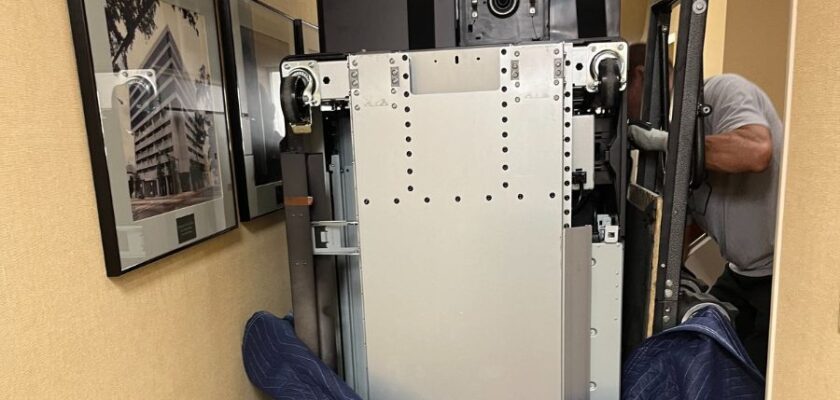
When it comes to packing and moving your electronics, it’s crucial to take the right steps to ensure their safety. You’ll want to start by unplugging everything and backing up important files.
But what’s next? Knowing how to protect your devices during transport can make all the difference.
Let’s explore effective packing techniques that will keep your gadgets safe throughout the move.
Preparing Your Electronics for the Move
Proper preparation is key to ensuring your electronics arrive at your new home safely and in working condition.
Unplug and Remove Batteries
Start by unplugging all electronics and removing any batteries, especially from devices like remotes, cameras, and other small gadgets.
- Prevent damage: Removing batteries helps avoid leaks or corrosion that can occur during the move.
- Discharge devices: Make sure devices are fully powered down to prevent any accidental turning on during transit.
Backup Your Data
Before packing, back up all important data stored on your electronics, such as photos, documents, and videos.
- Digital protection: This ensures that, in case of damage, you don’t lose crucial files or information.
- Cloud storage: Consider using cloud storage services or external drives for an additional layer of protection.
Pack and Label Properly
Use the original boxes for electronics if available; they’re designed to keep your devices safe during transport.
- Alternative packing: If you don’t have the original packaging, wrap devices in bubble wrap or soft cloths for cushioning.
- Label cables and accessories: Clearly mark cables and accessories to make unpacking easier later on.
By carefully preparing your electronics, you’ll minimize the risk of damage and ensure a smooth transition to your new home with all your devices intact.
Packing Techniques for Safe Transportation
When moving your electronics, using the right packing techniques will help ensure they arrive safely at your new home.
Use Original Packaging When Possible
Whenever possible, use the original packaging for your electronics.
- Designed for protection: Original boxes are made specifically to protect the device during transport.
- Secure fit: These boxes typically come with custom inserts that keep the items stable and safe.
Wrap and Cushion Your Electronics
If you no longer have the original packaging, wrap each item in bubble wrap or foam to protect it.
- Padding is essential: Ensure there’s enough padding around the device to absorb shocks during transit.
- Secure with tape: Use strong tape to hold the wrapping in place, preventing it from unraveling during the move.
Organize Cables and Accessories
Bundle cables and accessories neatly to avoid tangling and potential damage.
- Use zip ties or twist ties: Secure cables to keep them organized and prevent damage.
- Label everything: Clearly label each box with its contents and the room it belongs to, making unpacking easier.
Proper Box Packing and Loading
Avoid overpacking boxes to prevent crushing or damaging your electronics.
- Use sturdy boxes: Make sure the boxes are strong enough to hold the weight of the items without breaking.
- Loading tips: When loading the vehicle, place heavier items at the bottom and ensure everything is secured tightly to prevent shifting during transit.
By following these packing techniques, you’ll ensure your electronics are protected and ready for a safe, stress-free move.
Setting Up Your Electronics in Your New Home
Once you’ve arrived at your new home, setting up your electronics in an organized manner will make the process easier and less stressful.
Plan the Layout for Your Devices
Before you start setting up, decide where each device will go.
- Access to power: Ensure there are enough power outlets for all devices.
- Cable management: Plan for where cables will go, using clips or ties to keep them neat and out of sight.
Start with the Essentials
Begin by connecting the most important electronics first, like your TV, computer, and router.
- One at a time: Set up each device individually to ensure everything works correctly before moving on.
- Label cords: Using labeled cords will help you easily identify which cable goes where.
Set Up Your Wi-Fi and Test the Connection
Don’t forget to set up your Wi-Fi network and test the connection.
- Test for strength: Check the connection in different areas of your home to make sure it’s stable throughout.
- Secure network: Ensure your Wi-Fi network is secure and password-protected.
Arrange Your Space Comfortably
Once all the electronics are connected, take time to arrange your space for comfort and accessibility.
- Easy access: Ensure all devices are easily accessible for maintenance or use.
- Create a comfortable setup: Organize your devices so your space feels comfortable and functional.
By following these steps, you’ll have your electronics set up quickly and efficiently, creating a seamless transition into your new home.
